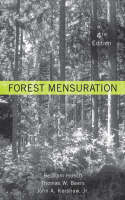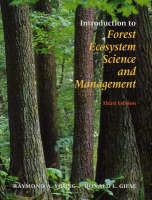Forest Mensuration
 -15%
portes grátis
-15%
portes grátis
Forest Mensuration
Husch, Bertram; Beers, Thomas W.; Kershaw, John A.
John Wiley and Sons Ltd
12/2002
456
Dura
Inglês
9780471018506
0471018503
15 a 20 dias
761
This edition presents an updated approach to forest measurement that takes into account all of a forest's resources, describes the use of mensuration as a monitoring tool, presents current forest management principles, and much more.
Preface.1 Introduction.1-1. Role of Forest Mensuration in Forest Management.1-2. Forest Mensuration as a Tool for Monitoring Forests.2 Principles of Measurement.2-1. Scales of Measurement.2-2. Units of Measurement.2-3. Systems of Measurement.2-4. Variables.2-5. Precision, Accuracy, and Bias.2-6. Signi.cant Digits and Rounding O.2-7. Data Summary and Presentation.2-8. Fundamental Measurements.3 Basic Statistical Concepts.3-1. Descriptive Statistics.3-2. Frequency Distributions.3-3. Measures of Central Tendency.3-4. Measures of Dispersion.3-5. Sampling Error.3-6. Sample Size Determination.3-7. Estimation of Totals.3-8. Regression and Correlation.3-9. Hypothesis Testing.4 Land Area Determination.4-1. Land Distance and Area Units.4-2. Measuring Distances.4-3. Measuring Area in the Field.4-4. Measuring Area Using Maps and Photos.4-5. Determination of Photo Scale.4-6. Determination of Direction Using a Compass.4-7. U.S. Public Land Surveys.4-8. Global Positioning Systems.4-9. Geographic Information Systems.5 Individual Tree Parameters.5-1. Age.5-2. Tree Diameters and Areas.5-3. Height.5-4. Form.5-5. Crown Parameters.6 Determination of Tree Volume.6-1. Determination of Cubic Volume.6-2. Volume Tables.6-3. Construction of Volume Tables.6-4. Volume Distribution in Trees.7 Determination of Tree Weight.7-1. Factors In.uencing Wood Weight Estimates.7-2. Tree Weight Relationships.8 Stand Parameters.8-1. Age.8-2. Species Composition.8-3. Diameter.8-4. Height.8-5. Density and Stocking.8-6. Volume and Weight.8-7. Site Quality.9 Measurement of Primary Forest Products.9-1. Units of Measurement.9-2. Log Rules.9-3. Board-Foot Log Rules.9-4. Cubic-Volume Log Rules.9-5. Log Scaling.9-6. Scaling Stacked Volume.9-7. Volume Unit Conversion.9-8. Scaling by Weight.10 Nontimber Forest Vegetation Parameters.10-1. Understory Vegetation.10-2. Woody Detritus.10-3. Forest Vegetation for Wildlife Management.10-4. Forest Biomass.10-5. Carbon Content.11 Sampling Units for Estimating Parameters.11-1. The Factor Concept.11-2. Fixed-Area Plots.11-3. Sampling Units with Variable Probability.11-4. Distance-Based Sampling Units.11-5. Selecting Appropriate Sampling Units.12 Forest Inventory.12-1. Timber Estimation.12-2. Nontimber Estimation.12-3. Inventory Planning.12-4. Forest Inventory Design.12-5. Inventory Fieldwork.12-6. Calculation and Compilation.13 Sampling Designs in Forest Inventories.13-1. Basic Considerations.13-2. Simple Random Sampling.13-3. Ratio and Regression Sampling.13-4. Cluster Sampling.13-5. Strati.ed Random Sampling.13-6. Multistage Sampling.13-7. Double Sampling.13-8. Nonrandom Sampling.13-9. Repeated Sampling in Forest Inventory.14 Inventory Using Sampling with Varying Probability.14-1. Horizontal Point Sampling.14-2. List Sampling.14-3. 3P Sampling.15 Growth of the Tree.15-1. Growth Curves.15-2. Height and Diameter Growth.15-3. Determination of Diameter Growth from Increment Cores.15-4. Stem Analysis.15-5. Areal and Volume Growth.15-6. E.ects of Environmental Factors on Growth.15-7. Growth Percentage.16 Stand Growth and Yield.16-1. Elements of Stand Growth.16-2. Growth and Yield Models.16-3. Using Stand Growth and Yield Models.16-4. Assessing Stand Growth and Yield in Forest Inventories.Appendix.References.Index.
Este título pertence ao(s) assunto(s) indicados(s). Para ver outros títulos clique no assunto desejado.
This edition presents an updated approach to forest measurement that takes into account all of a forest's resources, describes the use of mensuration as a monitoring tool, presents current forest management principles, and much more.
Preface.1 Introduction.1-1. Role of Forest Mensuration in Forest Management.1-2. Forest Mensuration as a Tool for Monitoring Forests.2 Principles of Measurement.2-1. Scales of Measurement.2-2. Units of Measurement.2-3. Systems of Measurement.2-4. Variables.2-5. Precision, Accuracy, and Bias.2-6. Signi.cant Digits and Rounding O.2-7. Data Summary and Presentation.2-8. Fundamental Measurements.3 Basic Statistical Concepts.3-1. Descriptive Statistics.3-2. Frequency Distributions.3-3. Measures of Central Tendency.3-4. Measures of Dispersion.3-5. Sampling Error.3-6. Sample Size Determination.3-7. Estimation of Totals.3-8. Regression and Correlation.3-9. Hypothesis Testing.4 Land Area Determination.4-1. Land Distance and Area Units.4-2. Measuring Distances.4-3. Measuring Area in the Field.4-4. Measuring Area Using Maps and Photos.4-5. Determination of Photo Scale.4-6. Determination of Direction Using a Compass.4-7. U.S. Public Land Surveys.4-8. Global Positioning Systems.4-9. Geographic Information Systems.5 Individual Tree Parameters.5-1. Age.5-2. Tree Diameters and Areas.5-3. Height.5-4. Form.5-5. Crown Parameters.6 Determination of Tree Volume.6-1. Determination of Cubic Volume.6-2. Volume Tables.6-3. Construction of Volume Tables.6-4. Volume Distribution in Trees.7 Determination of Tree Weight.7-1. Factors In.uencing Wood Weight Estimates.7-2. Tree Weight Relationships.8 Stand Parameters.8-1. Age.8-2. Species Composition.8-3. Diameter.8-4. Height.8-5. Density and Stocking.8-6. Volume and Weight.8-7. Site Quality.9 Measurement of Primary Forest Products.9-1. Units of Measurement.9-2. Log Rules.9-3. Board-Foot Log Rules.9-4. Cubic-Volume Log Rules.9-5. Log Scaling.9-6. Scaling Stacked Volume.9-7. Volume Unit Conversion.9-8. Scaling by Weight.10 Nontimber Forest Vegetation Parameters.10-1. Understory Vegetation.10-2. Woody Detritus.10-3. Forest Vegetation for Wildlife Management.10-4. Forest Biomass.10-5. Carbon Content.11 Sampling Units for Estimating Parameters.11-1. The Factor Concept.11-2. Fixed-Area Plots.11-3. Sampling Units with Variable Probability.11-4. Distance-Based Sampling Units.11-5. Selecting Appropriate Sampling Units.12 Forest Inventory.12-1. Timber Estimation.12-2. Nontimber Estimation.12-3. Inventory Planning.12-4. Forest Inventory Design.12-5. Inventory Fieldwork.12-6. Calculation and Compilation.13 Sampling Designs in Forest Inventories.13-1. Basic Considerations.13-2. Simple Random Sampling.13-3. Ratio and Regression Sampling.13-4. Cluster Sampling.13-5. Strati.ed Random Sampling.13-6. Multistage Sampling.13-7. Double Sampling.13-8. Nonrandom Sampling.13-9. Repeated Sampling in Forest Inventory.14 Inventory Using Sampling with Varying Probability.14-1. Horizontal Point Sampling.14-2. List Sampling.14-3. 3P Sampling.15 Growth of the Tree.15-1. Growth Curves.15-2. Height and Diameter Growth.15-3. Determination of Diameter Growth from Increment Cores.15-4. Stem Analysis.15-5. Areal and Volume Growth.15-6. E.ects of Environmental Factors on Growth.15-7. Growth Percentage.16 Stand Growth and Yield.16-1. Elements of Stand Growth.16-2. Growth and Yield Models.16-3. Using Stand Growth and Yield Models.16-4. Assessing Stand Growth and Yield in Forest Inventories.Appendix.References.Index.
Este título pertence ao(s) assunto(s) indicados(s). Para ver outros títulos clique no assunto desejado.




